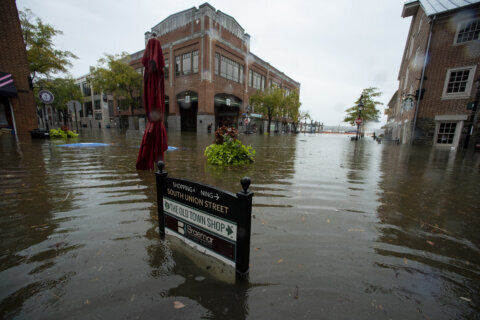Just as the remnants of Hurricane Ian head north from the Carolinas into the WTOP listening area, a look back to previous hurricanes that have significantly impacted the region shows that the “I’s” have it.
The naming of tropical storms and hurricanes didn’t start until 1952, and it wasn’t until the last two decades that hurricanes that started with “I” had a bad reputation in the D.C. area.
Hurricane Isabel (2003): Category 2 Isabel made landfall near Drum Point, North Carolina, in mid-September with maximum sustained winds of 105 mph, then pushed into western Pennsylvania on Sept. 19. Isabel left more than 2 million people in the dark across the mid-Atlantic. Six to 12 inches of rain produced major flooding in the Shenandoah Valley, with 1 to 3 inches of rain in the Baltimore-Washington region.
Major flooding unfolded on the Potomac, Shenandoah, Rapidan and Rappahannock rivers. Isabel’s storm surge on the Chesapeake Bay and Potomac River reached 6 to 8 feet above normal. Old Town Alexandria, King Street, Georgetown at the foot of Wisconsin Avenue and the headquarters of the police and fire harbor patrol at Water Street flooded during Isabel.
Hurricane Ivan (2004): Just one year after Isabel, Hurricane Ivan produced 32 tornadoes in the Sterling, Virginia, forecast area in late September. The strongest tornado was near Remington, where an F3 (before the scale was updated to the Enhanced Fujita scale) injured 12 people. Ivan made landfall along the central Gulf Coast and then cut across the Appalachians into southern Virginia.
Hurricane Irene (2011): Irene swept across Puerto Rico Aug. 21, then turned northeast and made landfall as a Category 1 hurricane near Cape Lookout, North Carolina, on Aug. 27, with maximum sustained winds of 85 mph. Irene pushed north and passed fewer than 15 miles off the coast of Ocean City, Maryland, and made a second landfall near Little Egg Inlet, New Jersey.
Irene damaged 1,000 homes and produced 850,000 outages in Maryland and D.C., and was responsible for the second-most power outages in Virginia’s history, with 2.5 million without power. Storm damage reached $13 million in Northern Virginia and central and Southern Maryland. Five to 10 or more inches of rain soaked the region, with Leonardtown topping the list with 11.52 inches. Roads were closed east of Interstate 95 and St. Clement Creek in St. Mary’s County set a record of 6.98 feet.
Hurricane Isaias (2020): Flooding inundated the region, with Leonardtown getting 9.15 inches of rain. Saint Clements Creek reached 2 feet above flood stage. Gusty winds overturned three tractor-trailers along U.S. Route 50 and triggered roof damage, downed trees and power lines. A 31-year-old woman was killed in St. Mary’s County when a tree fell on the vehicle she was inside. More than 60,000 customers lost power in Maryland. Isaias tracked right along the East Coast in early August.
(A lot of people learned how to pronounce Isaias for the first time during that storm. Bet you forgot.)
Hurricane Ida (2021): Right at very beginning of September, Ida cut a path from the central Gulf Coast to the mid-Atlantic. Ida produced 3 inches or more of rain locally, with 8 inches falling in Frederick, Maryland, that triggered flooding. Two tornadoes touched down in Maryland, an EF0 and EF2 closer to the Chesapeake Bay. One death was attributed to Ida in the D.C. area.
Hurricane Ian (2022): Ian made a first landfall in western Cuba, then a second along Florida’s Gulf Coast in late September, and its third and last in Georgetown, South Carolina, Sept. 30. Ian is tracking north and will stall over the mid-Atlantic this weekend.
The main hazards with Ian include sporadic flash flooding through early Saturday as the first wave of downpours soak the region. Persistent breezy to occasionally windy conditions will create sporadic power outages and downed trees (mainly those with weak root systems), and coastal/beach erosion for the mid-Atlantic beaches. The easterly fetch will push the water in the Chesapeake Bay and Potomac River onto adjacent roads and create coastal flooding.
Remember: If you approach a flooded roadway, “Turn Around, Don’t Drown.” Water is usually deeper than what it appears, and it only takes 6 inches of water to cause a vehicle to stall — and 2 feet to cause it to float. Stay with WTOP for the latest coverage on Ian.








